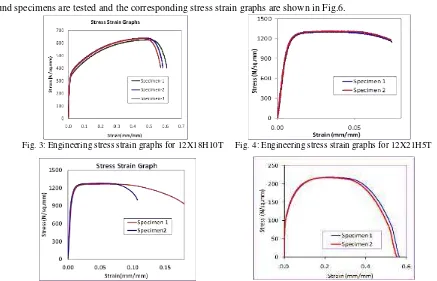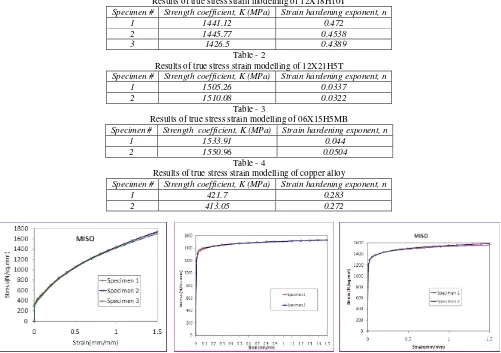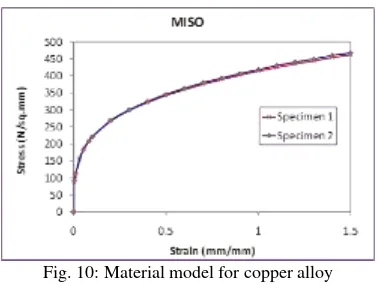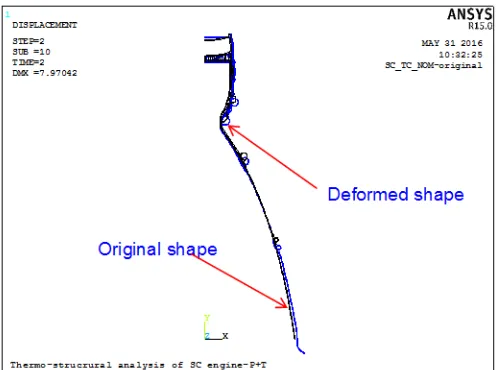Jean Molly Simon Krishnajith Jayamani
Assistant Professor Engineer
Mar Baselios College of Engineering Trivandrum SDAG/LPSC/ISRO Trivandrum
Abstract
High thrust rocket engines are employed in satellite launch vehicles delivering heavy satellites and space-crafts. The thrust chamber of such engines are generally of double walled construction in which the inner wall is of a high conductivity high ductility material like a copper alloy and outer wall of stainless steel. During engine operation, the chamber will be subjected to thermal and pressure loads. Due to severe thermal and pressure loads, inner wall operates in the elasto-plastic condition. Repeated operation of the engine will thus cause cyclic plastic deformations inducing low cycle fatigue. The thrust chamber investigated is of double walled construction in which four metallic materials are used at different zones: three stainless steels (designated as 12X21H5T, 12X18H10T and 06X15H10T respectively which have varying strength properties) and a high conductivity copper alloy which contains traces of Chromium, Zirconium and Titanium. A material characterization program is initiated to evaluate the monotonic tensile properties of the above materials at room temperature, in a Universal Testing Machine. This paper presents the constitutive modeling of the above materials followed by finite element modelling and thermo structural analysis of the thrust chamber.
Keywords: ANSYS, Semi-Cryo, Thrust Chamber, UTM, Stress Analysis
________________________________________________________________________________________________________
I. INTRODUCTION
The thrust chamber consists of cylindrical section where combustion occurs, a section narrowing towards throat, and a bell shaped, expanding nozzle section through which the combustion gases are expelled. Regenerative cooling of the thrust chamber is achieved by passing kerosene through rectangular coolant passages milled to outer surface of the inner wall. The number of coolant passages vary along the length of the chamber.[1] The outer and inner walls are attached together by brazing at high temperature in a vacuum furnace. Fig.1 shows configuration of the thrust chamber. Fig.2 shows a typical cross section of the same.
Fig. 2: Cross section of the thrust chamber [2]
II. EXPERIMENTAL INVESTIGATION
Tension tests are carried out at room temperature in an INSTRON 8862 electromechanical UTM having a load rating of 100 kN. Deformation of the specimen is measured using an extensometer [3]. Both round and flat specimens can be tested in the machine. The machine supports testing at ambient and elevated temperatures. The specimens are fabricated and tested till failure as per ASTM E-8 standards [7].
Tension Testing of 12X18H10T
12X18H10T is a medium strength stainless steel. Fig. 3 shows the engineering stress strain graph for each specimen.
Tension Testing of 12X21H5T
12X21H5T is a high strength stainless steel. This material can readily be welded to both copper alloy as well as 12X18H10T and hence is used as an interfacing material to join the inner wall copper alloy to the 12X18H10T material inner wall in the divergent zone. Two flat specimens are tested in this case and the corresponding engineering stress strain graphs are shown in Fig.4.
Tension Testing of 06X15H5MB
06X15H5MB is a special type high strength steel. Two round specimens are tested and the stress strain graphs are shown in Fig.5.
Tension Testing of Copper alloy using Smooth Round Specimens
Two round specimens are tested and the corresponding stress strain graphs are shown in Fig.6.
Fig. 3: Engineering stress strain graphs for 12X18H10T Fig. 4: Engineering stress strain graphs for 12X21H5T
Table-1 shows strength coefficient and strain hardening exponent fitted to the true stress-strain data for the 3 specimens. True stress-strain graphs are shown in Fig.7. The material exhibited strain hardening beyond yielding. All the specimens showed nearly same behaviour.
Constitutive modelling of 12X21H5T
Table-2 shows strength coefficient and strain hardening exponent for the specimens. True stress-strain graphs are shown in Fig.8. The material exhibited elastic-perfectly plastic behaviour. All the specimens showed same trend.
Constitutive Modelling of 06X15H5MB
Table-3 shows strength coefficient and strain hardening exponent for the specimens. True stress-strain graphs are shown in Fig.9. The material exhibited elastic-perfectly plastic behaviour. All specimens showed similar trend.
Constitutive Modelling of Copper Alloy
Table-4 shows strength coefficient and strain hardening exponent for the specimens. True stress-strain graphs are shown in Fig. 10. The material exhibited strain hardening beyond yielding. All specimens showed similar behaviour.
Table - 1
Results of true stress strain modelling of 12X18H10T
Specimen # Strength coefficient, K (MPa) Strain hardening exponent, n
1 1441.12 0.472
2 1445.77 0.4538
3 1426.5 0.4389
Table - 2
Results of true stress strain modelling of 12X21H5T
Specimen # Strength coefficient, K (MPa) Strain hardening exponent, n
1 1505.26 0.0337
2 1510.08 0.0322
Table - 3
Results of true stress strain modelling of 06X15H5MB
Specimen # Strength coefficient, K (MPa) Strain hardening exponent, n
1 1533.91 0.044
2 1550.96 0.0504
Table - 4
Results of true stress strain modelling of copper alloy
Specimen # Strength coefficient, K (MPa) Strain hardening exponent, n
1 421.7 0.283
2 413.05 0.272
Fig. 10: Material model for copper alloy
IV. STRESS ANALYSIS OF THRUST CHAMBER
Structural behaviour of thrust chamber is studied using axi-symmetric model by supplying Multilinear isotropic hardening material model parameters. Thermal expansion secant coefficient and thermal conductivity at different temperatures obtained from literature are given for inner and outer wall materials. For modelling ribs, orthotropic material properties are used[4]. The structure has been analyzed for the operating condition. Since coolant channels are milled in a helical pattern the ribs are
idealized as an orthotropic material with different Young’s modulus, Poisson’s ratio and shear modulus in the hoop, meridional and axial directions. Mechanical properties at higher temperatures for the above materials are taken from internal design documents. The top nodes of the chamber are supported in the axial direction. Combined material and geometric nonlinear stress analysis is done using ANSYS (Version 15.0).
Determination of Orthotropic Properties of RIBS
The orthotropic properties of the helical ribs are determined by the following formulae : Modulus of elasticity in radial direction
Modulus of elasticity in axial direction
During combustion, the chamber will be loaded by internal pressure and thermal loads which will directly act on the inner wall. The double walled construction permits the fuel to be passed through the space between the inner and outer walls for enhanced cooling of the inner wall [4]. Due to severe thermal and pressure loads, it is observed that the inner wall operates in elasto-plastic condition.
Pressure loads
The pressure inside the chamber is known as gas pressure while that in the coolant passages is called coolant pressure. Both these loads vary along the length of the chamber.
Thermal Loads
Varying thermal loads are applied to each and every sections of chamber as per the actual condition at which the chamber operates.
Thermo Structural Analysis
Fig. 11: Deformed shape of the thrust chamber at peak load
V. CONCLUSIONS
The 12X18H10T stainless steel exhibited medium strength (yield = 290 N/sq.mm, ultimate = 624 N/sq.mm). Mode of failure of all specimens is found to be ductile. 12X21H5T stainless steel exhibited high strength (yield = 1148 N/sq.mm, ultimate = 1305 N/sq.mm) and low ductility. Similarly, 06X15H5MB also exhibited high strength (yield = 1091 N/sq.mm, ultimate = 1267 N/sq.mm) and low ductility. The copper alloy exhibited low strength (yield = 86 N/sq.mm, ultimate = 217 N/sq.mm) but high ductility. Consistent test results are obtained for the specimens tested in each lot. All the manifolds are found to be in the elastic condition, maximum equivalent stress being 339 N/sq.mm which has a margin of safety of 0.98 against yielding. Maximum plastic strain of 2% is found to occur at the 12X18H10T to copper alloy weld region near to the throat.
ACKNOWLEDGMENT
The first author gratefully acknowledges the Director, LPSC/ ISRO and Dr. R. Muthukumar, Deputy Director, MDA/ LPSC for permitting to use the creep test facility and computational resources for this work.
REFERENCES
[1] Asraff A. K., Sunil S., Muthukumar R., and Ramanathan T. J., “New Concepts in Structural Analysis and Design of Double Walled LPRE Thrust
Chambers”, Proceedings of 42nd AIAA/ASME/SAE/ASEE Joint Propulsion Conference, 2006, pp. 1–13.
[2] A.K.Asraff, S.Sheela, Krishnajith Jayamani, S.Sarath Chandran Nair and R.Muthukumar, "Material characterisation and constitutive modelling of a copper alloy and stainless steel at cryogenic and elevated temperatures", Materials Science Forum, 2015.
[3] A. K. Asraff, Anju Paul, Ansu Mathew, S. Sheela, S. Savithri, “Cyclic Stress Analysis Of A Rocket Engine Thrust Chamber Using Chaboche, Voce And
Creep Constitutive models”, Conference proceedings, 7th International Conference on Creep, Fatigue and Creep-Fatigue Interaction, IGCAR, Kalpakkam,
2016.
[4] Aneena Babu, Asraff A. K., and Philip N., “Fatigue Life Prediction of a Rocket Combustion Chamber,” IOSR Journal of Mechanical and Civil
Engineering, Vol. 11, No. 5, 2014, pp. 12–20.
[5] David Roylance, “Stress-strain Curves”, Department of Materials Science and Engineering, Massachusetts Institute of Technology, Cambridge, 2001.
![Fig. 1: Configuration of the thrust chamber [2]](https://thumb-ap.123doks.com/thumbv2/123dok/3213099.1738295/1.612.215.396.489.719/fig-configuration-thrust-chamber.webp)



